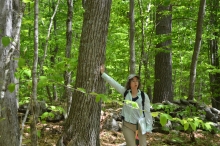You are here
Causes & Consequences of Tree Mortality from Invasive Insects: Dissertation by Audrey Barker Plotkin

We know that many tree species in the region are threatened by invasive insects, but why these trees die – and what happens next in the forest – has often remained unclear. Harvard Forest Senior Scientist and Site Manager Audrey Barker Plotkin examined these questions in her doctoral dissertation presentation on April 3 at UMass Amherst’s Department of Environmental Conservation.
Barker Plotkin, who joined the Harvard Forest team as a Research Assistant in 1998, has been studying the effects of invasive insects on trees at Harvard Forest for 20 years. For her dissertation, Causes and Consequences of Tree Mortality from Invasive Insects, Barker Plotkin discussed the effects of spongy moth (Lymantria dispar) and hemlock woolly adelgid (Adelges tsugae) on oaks and hemlocks, key tree species in Northeastern forests.
![[<i>The 2022</i> Future of Oak <i> research team included students, collaborators, and many oaks. By Sophie Everbach.</i>]](/sites/default/files/755/ABP_TeamOak.jpg)
Spongy moth defoliation: How does it affect energy stores and oak mortality?
Barker Plotkin carefully extracted cores from oak trees affected by a recent spongy moth outbreak and measured stored sugars and starches. She found that severely defoliated trees drew down their energy reserves, sometimes to zero, and those that died had extremely low reserves. By limiting the capacity of trees to photosynthesize, spongy moth defoliation led to decreased production of sugar – essentially starving the tree (find out more).
Next, Barker Plotkin put these findings into context by examining 50 years of forest growth and response to two spongy moth outbreaks at the Quabbin Reservoir Watershed Forest, building on her work at the Harvard Forest Lyford Plot. Using permanent plot records of tree growth and mortality, she found that although oaks remain a prominent component of the forest, spongy moth outbreaks are a major cause of oak mortality, especially for smaller trees, which may have lower starch and sugar reserves.
Hemlock woolly adelgid and the reorganization of a foundational habitat
Barker Plotkin also studied the consequences of the invasive hemlock woolly adelgid on Eastern hemlock (Tsuga canadensis) forests. These insects feed on the underside of hemlock needles, causing, as Barker Plotkin lovingly described it, “death by millions of tiny vampires.” As many forest managers consider salvage logging, Barker Plotkin sought to understand how the effects of standing dead hemlocks differ from human-mediated logging by synthesizing 15 years of data from the Harvard Forest’s Hemlock Removal Experiment.
Leaving dead trees standing resulted in a larger number of understory plant species and higher aboveground carbon stocks than salvage logging. Thus, while salvage logging may be appropriate to meet certain objectives, managers can support the forest’s capacity to respond to compounding disturbances in a changing world by allowing nature to run its course.
![[<i>Audrey Barker Plotkin discusses oak research in 2015. By Jenny Hobson. <i>]](/sites/default/files/755/ProspectHill_2015_AudreySpeaks_JLH.jpg)
An inspiration to the Harvard Forest community
Barker Plotkin juggled her roles as a Co-PI of the Harvard Forest LTER program, Site Manager/Forester, and Director of the Harvard Forest Summer Research Program in Ecology while leveraging her Harvard Forest-based research into her doctoral dissertation. Along the way, she mentored and inspired many undergraduate interns in their study of the “insects of doom.” Leading with contagious good humor, collaboration, an open mind, and determination, Audrey continues to be an inspiration to the Harvard Forest community.

